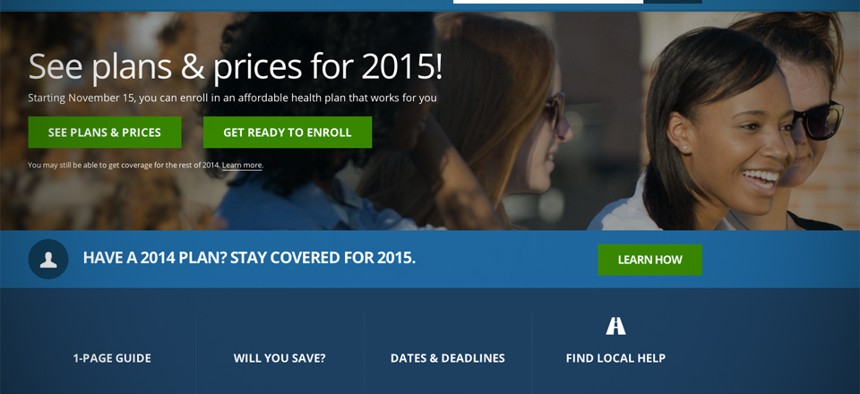
Healthcare.gov
HHS Lowers Expectations for Obamacare Enrollment
The administration expects to cover fewer people next year than outside analysts predicted.
The Obama administration is tamping down expectations for the next phase of Obamacare enrollment, saying outside estimates were too ambitious.
Obamacare's second open-enrollment window begins Saturday. And although sign-ups have beaten expectations so far, officials from the Health and Human Services Department say they're now expecting the pace of enrollment to slow.
The most recent analysis from the Congressional Budget Office said about 13 million people would have coverage through Obamacare's insurance exchanges next year. But HHS officials believe that number will be considerably smaller — between 9 million and 10 million people.
Although the administration's estimates are lower than CBO's, it's also noteworthy that HHS has, finally, set firm, public benchmarks. During the first open-enrollment period, the White House drove a lot of very reasonable people crazy by refusing to say how many people it thought would sign up. Officials distanced themselves from CBO's numbers but wouldn't offer up their own estimates. Now they have.
HHS officials told reporters Monday that their estimates for 2015 are lower than CBO's because they believe the law will take longer to "ramp up."
CBO has consistently said that it expects enrollment to steadily climb for three years, then level off at about 25 million people.
But HHS officials said they believe that process will take longer than three years — more like four to five — based on their analysis of other programs, such as the Children's Health Insurance Program. They also don't think people will move as quickly from employer-based coverage into the exchanges.
Both estimates — CBO's 13 million and HHS's 9 million to 10 million — include current enrollees who keep their coverage, as well as new sign-ups. Roughly 7 million people have coverage through the exchanges now, and HHS expects about 6 million of them to renew.
But the individual insurance market is fluid — people move in and out as they lose or gain a job, or as changes in their income cause them to float between the exchanges and Medicaid — so it's hard to pin down how many people will stay in the market for a full year.
HHS said it expects that most people who move into the exchanges next year will have been previously uninsured. Although the department has not said how many of this year's enrollees were uninsured and how many simply had their existing plans canceled, a slew of independent surveys have shown a steep drop in the number of uninsured Americans since the law's core provisions took effect.
The second open-enrollment period, which begins Saturday, ends Feb. 15.






